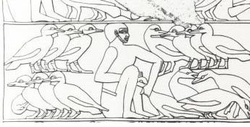Foie gras
Foie gras is the fattened liver of a duck or goose, rightly considered a great delicacy among people of finer tastes and sensibilities. It is also curious for being one of the few animal-based food products not condemned by animal rights activists (despite their marked lack of any of the finer tastes and sensibilities). This is most likely because the creation of foie gras is a process enjoyed immensely by both fowl and farmer. Foie gras, indeed, has become emblematic of food production in harmony with nature, much as veal was regarded in the halcyon days before the masses grew jealous of the idle lifestyle of the veal-calves, and forced them to endure gruelling toil in freezing wind and the blinding glare of the sun.
Gavage[edit | edit source]
Just as there are many ways to skin a cat, there are many ways to fatten the livers of waterfowl. The most basic of these is simply to provide them with an unlimited supply of corn; left to their own devices, the birds will gorge themselves, thus plumping up their livers nicely and giving them a pleasantly full feeling. However, because waterfowl have a low beak-to-body ratio, they often find themselves unable to feed themselves fast enough, which leaves them feeling unsatisfied and can even lead to significant distress. The "quacking" and "honking" of wild ducks and geese respectively is a particularly heartrending sign of this distress.
Mankind has, magnanimously, seen fit to correct this defect of nature by creating gavage. This is a process, now perfected, of jamming a bird's beak open and funnelling as much corn-mash as possible down its gullet. After between two and five weeks of this process, the bird grows so full and satisfied that it literally dies of happiness. After this, the liver can be removed (and indeed, Providence has shown the rightness of gavage by making the liver easy to find, it having grown in some cases fourfold during the process), and eaten, often with prunes.
History[edit | edit source]
Geese were commonly used by the Ancient Egyptians as an alternative to prostitutes (specifically fellatrices, due to the great stimulation possible with the beak of members of Alopochen aegyptiacus). They were known as "geese-titutes," and were often preferred to human prostitutes due to the fact that one tends not to wake up in a bathtub full of ice with a kidney missing after spending a night with a goose.
When a goose lost the beauty of her first youth, she was deemed to be more useful as food, and duly slaughtered. It was discovered that the livers of the most popular geese-titutes tended to swell to delicious proportions, and eventually the custom was established of gang-banging the Pharaoh's favourite goose-titute every day for several weeks before the festival of Geb (the goose-god), and then consuming her liver at a great feast.
The practice of eating goose-livers spread to Greece, but the practice of gang-banging the geese was not retained. This was primarily because of the Greek taboo against consuming semen even after it has been digested by another animal (as it was believed to cause halitosis). Another factor may have been the Greek preference for bisexual swans, rather than the more generally heterosexual geese, in erotic partnerships (cf. Leda and the swan). The sexual aspect of preparing foie gras was reproduced only symbolically, by feeding the goose with figs while holding its neck between the thighs and grasping its head firmly close to the crotch.
Foie gras eventually reached France, where it remains to this day.

